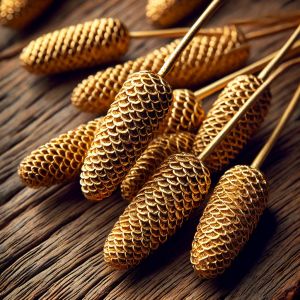Golden Alder
The Golden Alder tree (Alnus aurum), closely related to the Common Alder, is renowned for its distinctive golden-hued catkins and wood. Its distribution mirrors that of the Common Alder, thriving in similar soil conditions. Due to its unique aesthetic properties, the Golden Alder has been heavily exploited, resulting in its near-extinction. Today, it is protected by law, and conservation efforts are in place to preserve the remaining populations. Its rarity has limited extensive study, but it holds significant potential in magical applications.
The Golden Alder is a tree of both ecological and cultural significance. While its rarity poses challenges, ongoing conservation efforts provide hope for its future survival and potential resurgence in its natural habitat.
Appearance
The Golden Alder tree shares many physical characteristics with the Common Alder (Alnus glutinosa). It typically grows to heights of 15-25 meters, with a trunk diameter of up to 1 meter. The bark is smooth and gray, almost white, becoming fissured with age. Its leaves are rounded to ovate, and have a slightly serrated margin. Unlike its cousin, they are not dark green, but of a yellow-golden colour. The most striking feature of the Golden Alder is its fruit: ca 5 cm long oval catkins which, upon maturing, take on a metallic golden sheen. The wood, when polished, also develops a distinctive golden shimmer, making it highly sought after for decorative uses.
Habitat
The Golden Alder is found in the same regions as the Common Alder, predominantly across Europe, the British Isles, and parts of Asia. It thrives in moist, nutrient-rich soils, often along riverbanks, wetlands, and floodplains. The tree prefers temperate climates and can tolerate periodic flooding, which helps it outcompete less flood-tolerant species. Despite its adaptability to various soil conditions, the Golden Alder has become rare due to over-exploitation and habitat loss.
Uses in Magic
In magical traditions, the Golden Alder holds unique properties unrelated to its golden appearance. Its wood is highly valued for crafting wands and staves used in protective and healing spells. The tree's inherent resilience to water and its association with renewal make it a powerful symbol in rituals aimed at regeneration and cleansing. Additionally, the fruits are often used in potions designed to enhance clarity and insight, believed to channel the tree's natural energy into the user. Despite these uses, the rarity of the Golden Alder means that such items are incredibly precious and often passed down through generations of magical practitioners. Beyond these traditional uses, the specific magical properties of the Golden Alder remain largely unexplored, adding to its mystique.
Conservation Status
Due to its significant decline, the Golden Alder is now classified as critically endangered. The extensive logging for its decorative wood has nearly wiped out natural populations. Current conservation efforts focus on habitat restoration and legal protection. It is illegal to fell Golden Alder trees, and various environmental organizations are working to cultivate and reintroduce the tree in suitable habitats. Conservationists are also conducting genetic studies to better understand the species and improve restoration success rates. Public awareness campaigns aim to highlight the importance of preserving this unique species for future generations.


